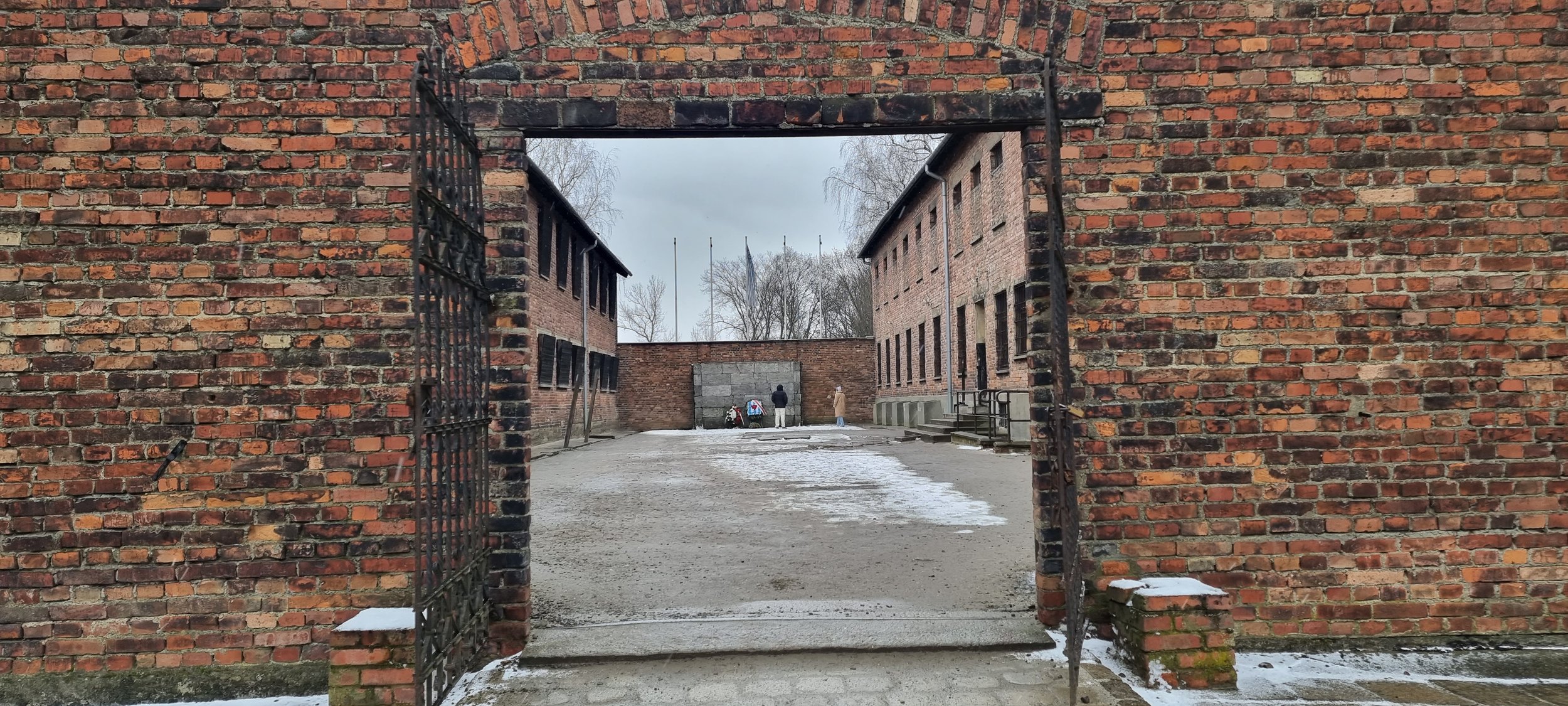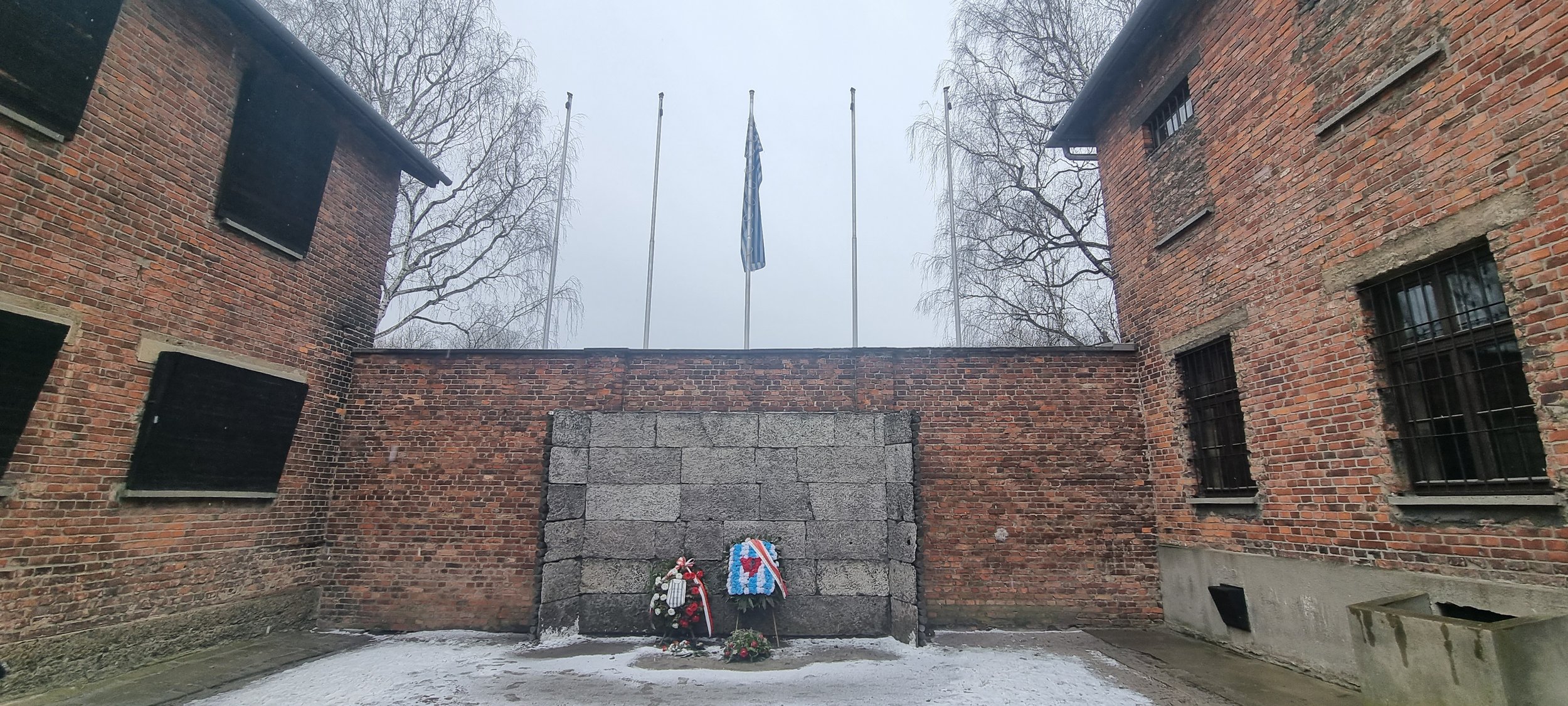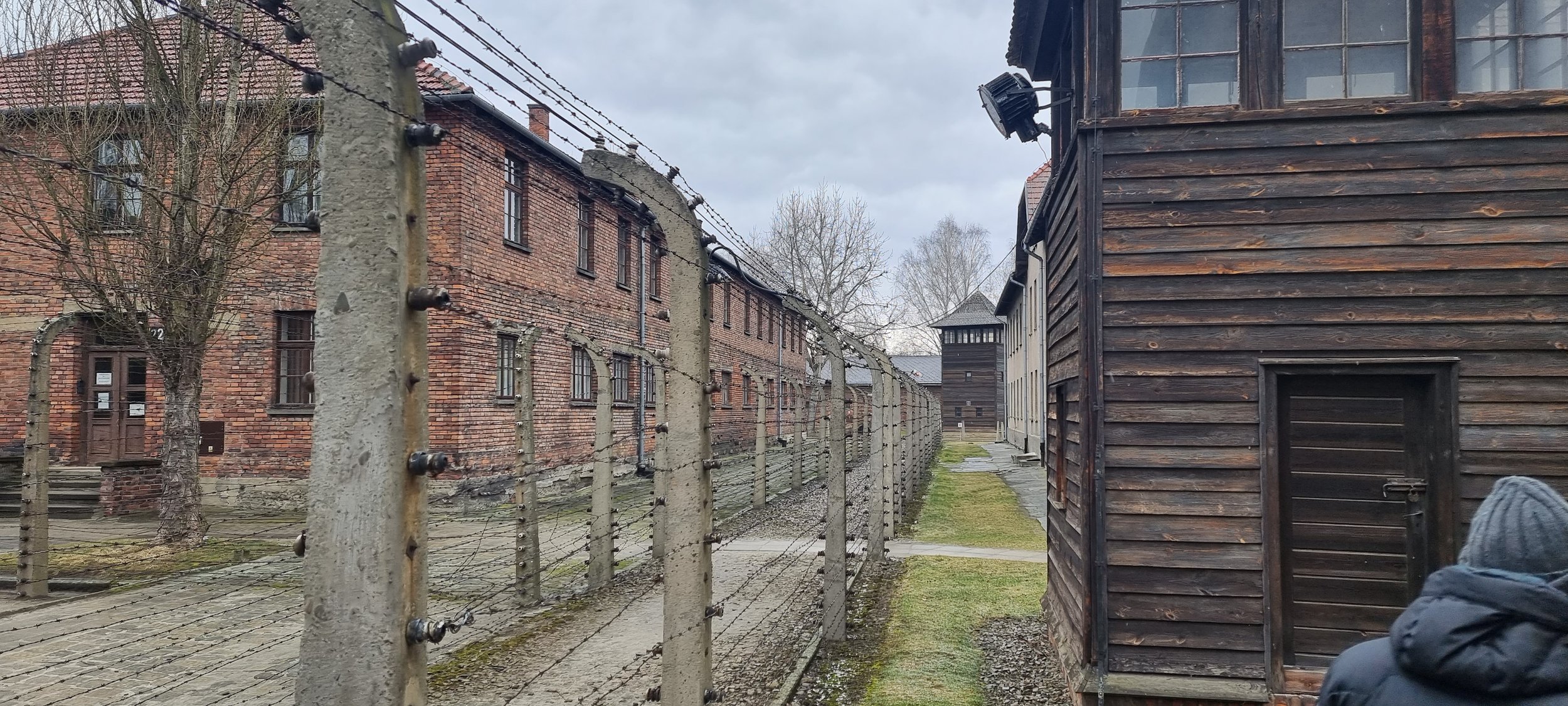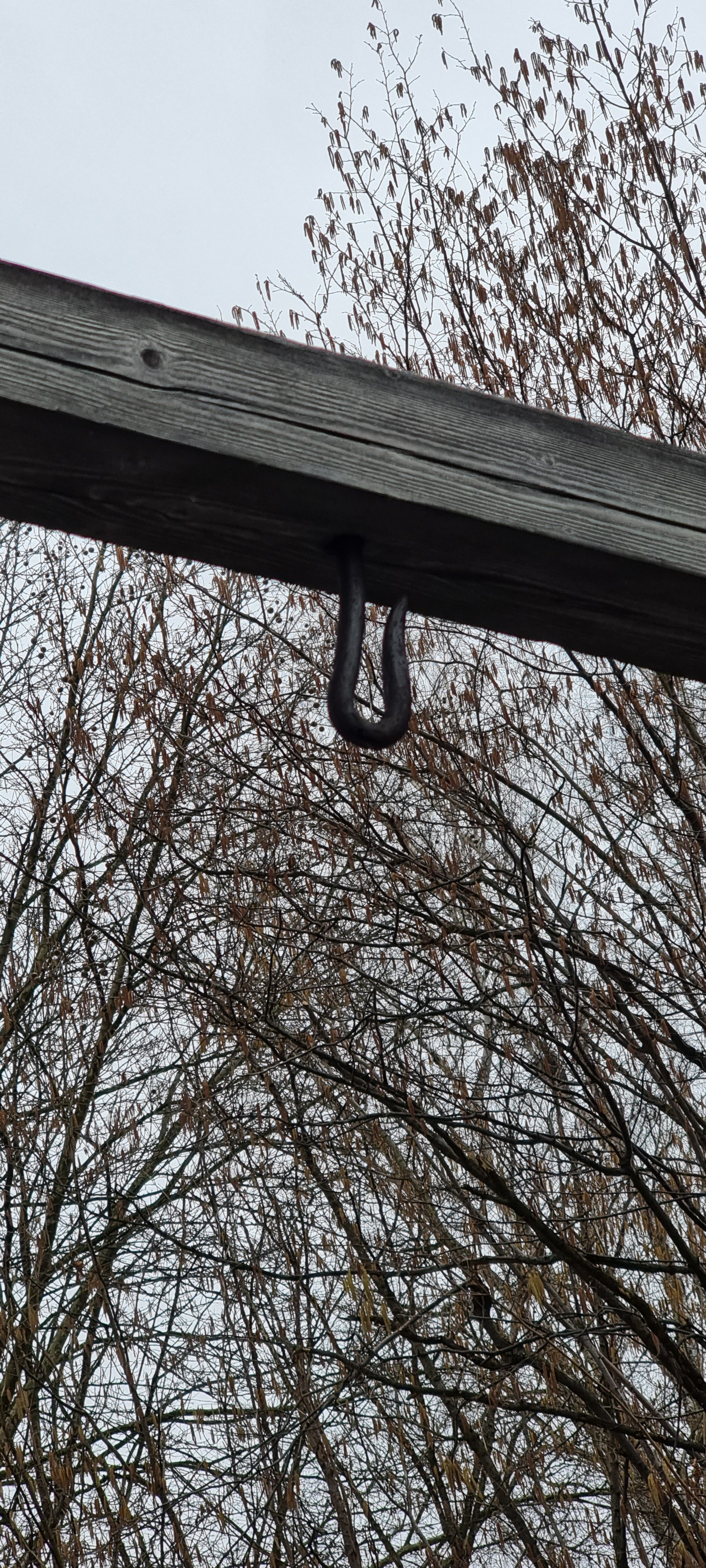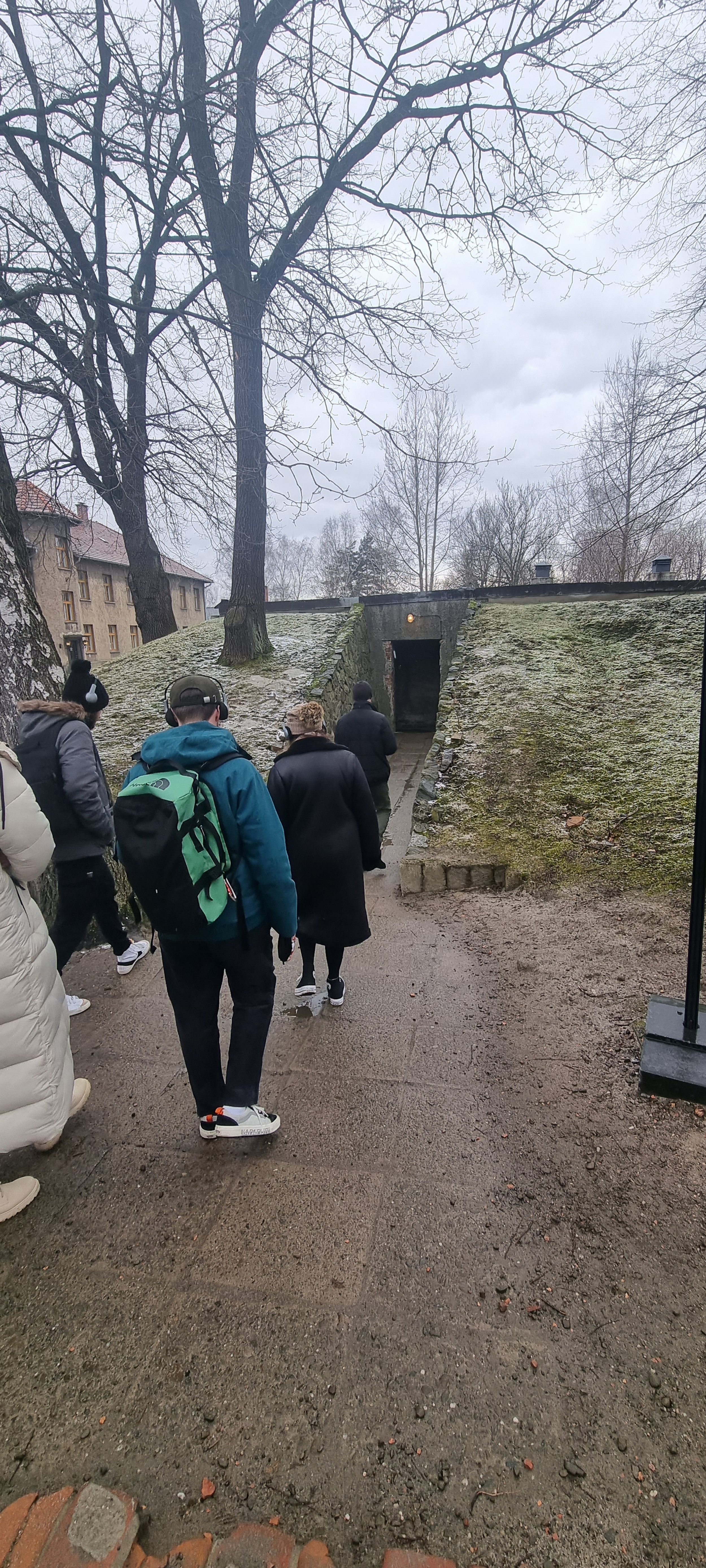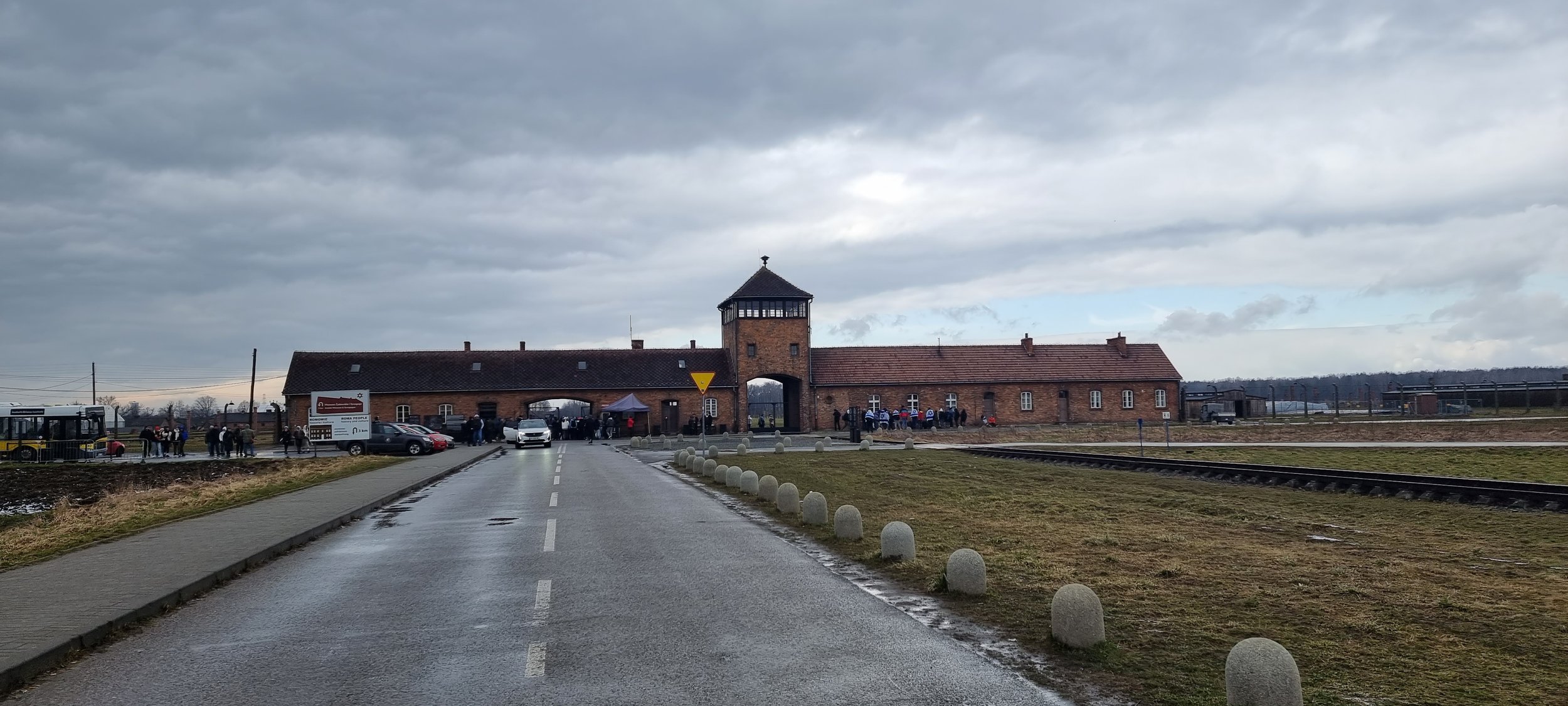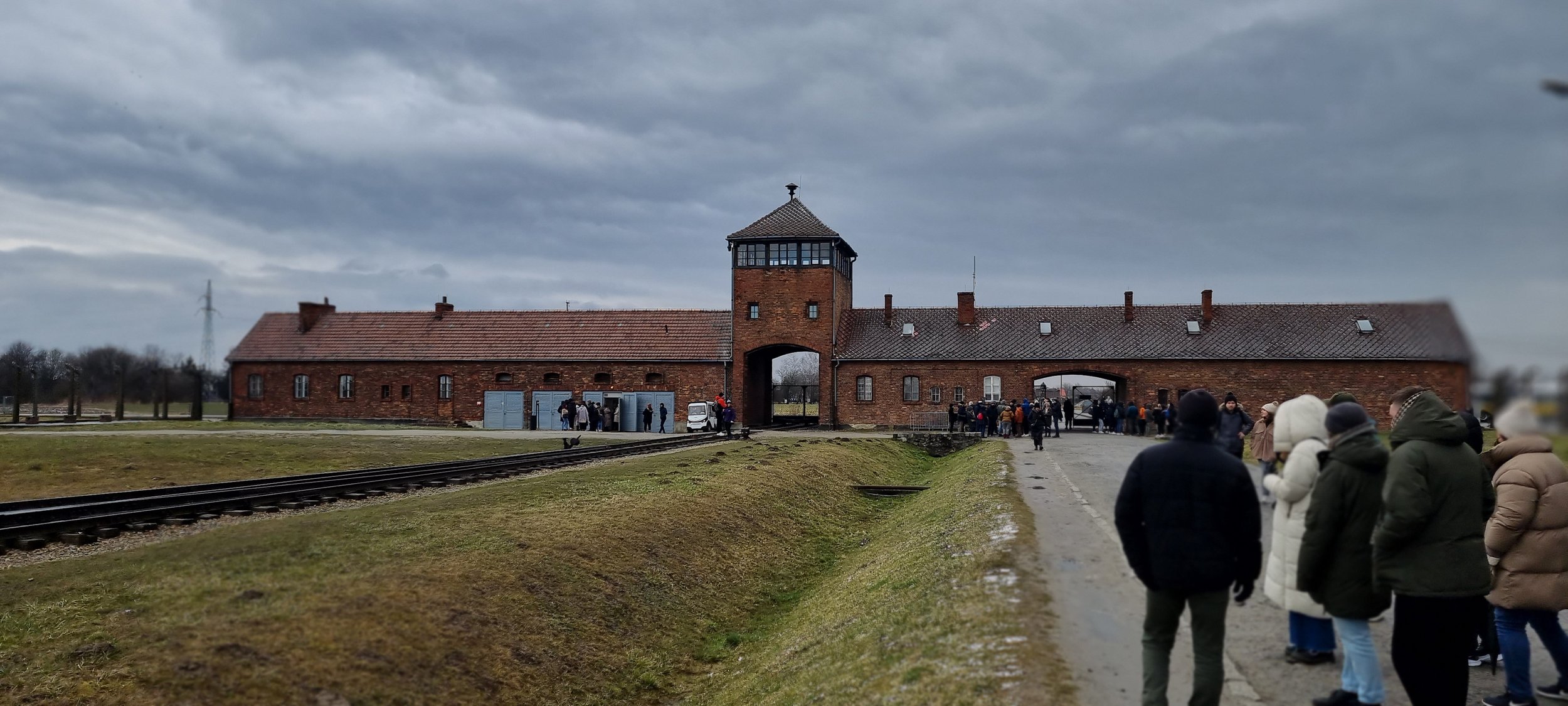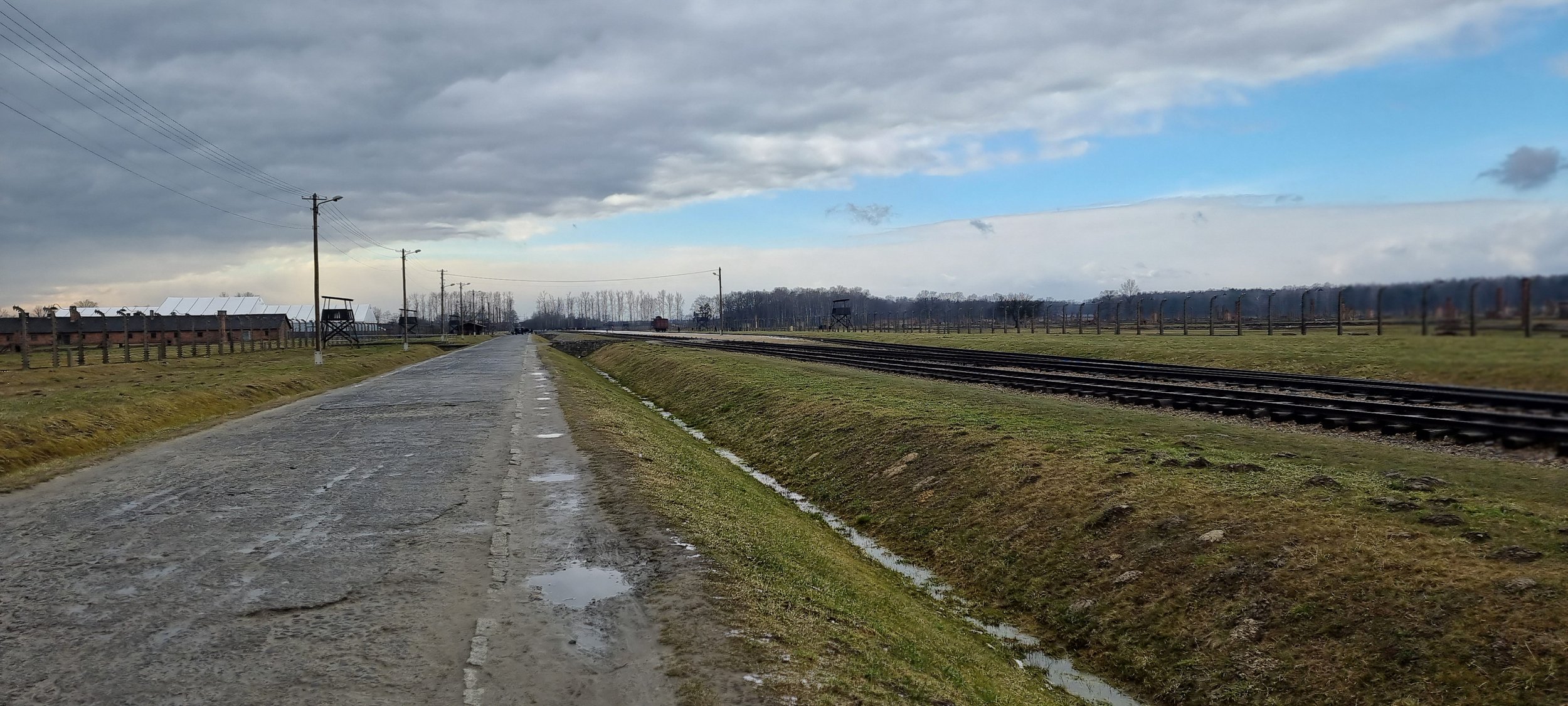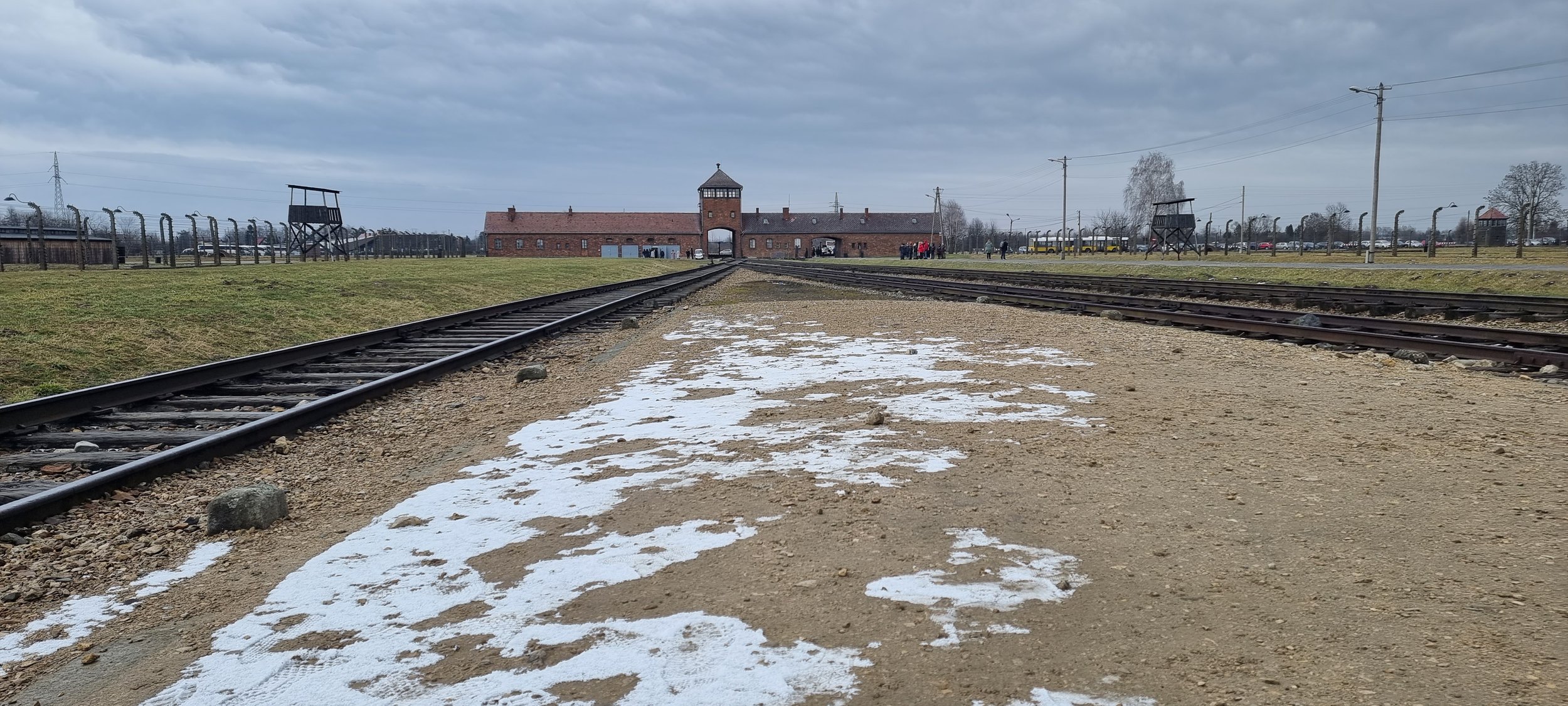
My Photos
Auschwitz
Auschwitz I, the main camp, was the first camp established near Oswiecim. Construction began in April 1940 in an abandoned Polish army barracks in a suburb of the city. SS authorities continuously used prisoners for forced labor to expand the camp. During the first year of the camp’s existence, the SS and police cleared a zone of approximately 40 square kilometers (15.44 square miles) as a “development zone” reserved for the exclusive use of the camp.
On May 20, 1940, the first prisoners arrived at Auschwitz. The transport consisted of some 30 German inmates, categorized as "professional criminals." The SS had selected them from the Sachsenhausen concentration camp outside of Berlin. Less than a month later, on June 14, German authorities in occupied Poland deported 728 Polish prisoners from a prison in Tarnow to Auschwitz. This was the first of many transports of Poles to the Auschwitz camp.
Like most German concentration camps, Auschwitz I was constructed for three purposes: - To incarcerate real and perceived enemies of the Nazi regime and the German occupation authorities in Poland for an indefinite period of time - To provide a supply of forced laborers for deployment in SS-owned construction-related enterprises (and, later, armaments and other war-related production) -To serve as a site to kill small, targeted groups of the population whose death was determined by the SS and police authorities to be essential to the security of Nazi Germany.
The camp authorities designated Blocks 19, 20, 21 and 28 as the "camp infirmary" for sick prisoners. Prisoners often referred to them as (waiting rooms for the crematoria.( The lack of basic medicines and medical care caused many deaths. In mid-1941, SS physicians began conducting selections among the patients. They chose the most enfeebled prisoners or those who did not seem likely to recover their health quickly, and killed them by lethal injection or in the gas chambers. Throughout the period when the "infirmary" was in operation, SS physicians carried out various types of medical and pharmacological experiments that usually led to the death of prisoners or left them permanently injured. Similar "hospitals" were located in other parts of Auschwitz concentration camp.
In 1943 Germans created a brothel for prisoners in Block 24 which is visible behind the main gate. One of remaining traces of the function of those rooms (camp brothel) is the size and peepholes in the doors. Today these are offices of the IT Section of the Museum.
A WVHA decree of March 31, 1942 established a minimum working day of eleven hours in all concentration camps. At Auschwitz, labor was one of the means used to destroy prisoners. They labored in various sectors of the economy. Initially, they worked at building the camp: leveling the ground, erecting new blocks and buildings, laying roads, and digging drainage ditches. Later, the industries of the Third Reich made increasing use of cheap prisoner labor. The pace of the work, the starvation rations of food, and constant beatings and abuse exacerbated the death rate. The German IG Farbenindustrie cartel, which built the Buna-Werke synthetic rubber and fuel factory at Monowice near Oswiecim, had priority in obtaining prisoner labor. The majority of the Auschwitz sub-camps were located near the mills, mines, and factories of Silesia. Prisoners dug coal, produced armaments and chemicals, and built and expanded industrial plants.
Block 10 was a barrack at the Auschwitz concentration camp where men and women were used as experimental subjects for Nazi doctors. The experiments in Block 10 ranged from testing bodily reactions to relatively benign substances and sterilization. Although Block 10 was in Auschwitz I, a part of the camp mainly used for male political prisoners, the experiments conducted were mostly on women. The main doctors who worked in Block 10 were Carl Clauberg, Horst Schumann, Eduard Wirths, Bruno Weber and August Hirt. Each of them had different methods in doing experiments on the inmates.
In December 1943, a 20-year-old named Ruth Elias arrived in a cattle car at the Auschwitz-Birkenau concentration camp. She was assigned to Block 6 in the family camp, a barracks that housed young women and the camp’s male orchestra, an ensemble of incarcerated violinists, clarinet players, accordion players and percussionists who played their instruments not just when the prisoners marched out for daily labor details, but also during prisoner floggings.
Maria Mandl writes - "In my block [Block 15], 700 women were chosen out of 1,000; in the whole camp (that is, in lager A, where we stayed in the so-called quarantine), Mandl selected several thousand women, and all of them – naked – were crammed into one block no. 25, where they stayed for seven days and nights without food or water. On the night of 27 September, they were transported to the crematorium"
Zyklon B was used in Germany before and during the Second World War for disinfection and pest extermination in ships, buildings and machinery. In the Auschwitz concentration camp as well, it was used exclusively for sanitation and pest control until the summer of 1941. After the end of August 1941, Zyklon was used in the camp, first experimentally and then routinely, as an agent of mass annihilation. Zyklon B consisted of diatomite, in the form of granules the size of fine peas, saturated with prussic acid. In view of its volatility and the associated risk of accidental poisoning, it was supplied to the camp in sealed metal canisters.
The first mass transport—of 728 Polish male political prisoners, including Catholic priests and Jews—arrived on 14 June 1940 from Tarnów, Poland. They were given serial numbers 31 to 758. In a letter on 12 July 1940, Höss told Glücks that the local population was "fanatically Polish, ready to undertake any sort of operation against the hated SS men". By the end of 1940, the SS had confiscated land around the camp to create a 40-square-kilometer (15 sq mi) "zone of interest" patrolled by the SS, Gestapo and local police. By March 1941, 10,900 were imprisoned in the camp, most of them Poles.
Prisoners were stripped of their own civilian clothing and forced to wear a uniform. Typically, this uniform was patterned with blue stripes, although this wasn’t always the case. Men were given a cap, trousers and jacket to wear. Women wore a dress or skirt with a jacket and kerchief for their head. Some uniforms, especially those of higher-ranking prisoners such as Kapos had pockets, which were extremely useful for concealing extra rations or having useful luxuries such as spoons or cutlery. Some prisoners also secretly sewed pockets into their uniforms. On their feet, prisoners wore wooden or leather clogs. Socks were not supplied, and as a result many prisoners suffered with sores from rubbing. This could be very dangerous in the poor and unhygienic conditions of most of the camps. The uniforms usually had each prisoner’s number stitched onto front left hand side of the uniform, as well as a triangle to show the category of prisoner to which they had been classified. Jews wore two yellow triangles which formed the Star of David, political prisoners wore red triangles, Roma wore brown triangles, although they were also sometimes classed as ‘asocials’, which was represented with black triangles, homosexuals wore pink triangles, and Jehovah’s Witnesses wore purple triangles. Prisoners clothing was usually inadequate for the conditions in which they were expected to work and live.
The block contained special torture chambers in which various punishments were applied to prisoners. Some could include being locked in a dark chamber for several days or being forced to stand in one of four standing cells called "Stehzelle" in German. Punishment in these special compartments (one square metre each, with a hole 5x5 cm for breathing), consisted of confining four prisoners, who were forced by the lack of space to remain standing all night for up to twenty nights, while still being forced to work during the day.
It was at Block 11 that the first attempts to kill people with Zyklon B were implemented in September 1941.
Block 11 was the name of a brick building in Auschwitz I, the Stammlager or main camp of the Auschwitz concentration camp network. This block was used for executions and torture. Between Block 10 and Block 11 stood the "Death Wall" (reconstructed after the war) where thousands of prisoners were lined up for execution by firing squad.
Located in the yard at the side of block 11. The condemned were led to the wall for execution. SS men shot several thousand people there—mostly Polish political prisoners and, above all, members of clandestine organizations. Executions were also carried out here on Poles brought in from outside with death sentences, including hostages detained in reprisal for Polish resistance movement operations. Cases are known in which prisoners from other groups—Jews and Soviet POWs—were shot. The wall was dismantled in 1944, while the camp was still in existence. This did not mean the end of executions, however. Prisoners were also subjected to other form of punishment in the yard, including flogging and "the post."
One of the camp streets next to the fence. On the left there are blocks 1 and 12. On the right—the commandant office bulding
As the number of prisoners brought to the expanding Auschwitz complex rose, so did the death rate. But if a corpse were separated from its uniform, identification was rendered all but impossible. With often hundreds of prisoners dying per day, other methods of identification were needed. In Birkenau, the method used to tattoo the Soviet prisoners of war was implemented for emaciated prisoners whose deaths were imminent; the tattoos were later made with pen and ink on the upper left forearm. By 1942, Jews had become the predominant group represented at Auschwitz. They were tattooed based on numbers in the regular series until 1944; their numbers were preceded by a triangle, most likely to identify them as Jews. By spring of 1943 most of the prisoners were being tattooed, even those who had been registered previously. There were, however, notable exceptions. Ethnic Germans, reeducation prisoners, police prisoners, and inmates selected for immediate extermination were not tattooed. While it cannot be determined with absolute certainty, it seems that tattooing was implemented mainly for ease of identification whether in the case of death or escape; the practice continued until the last days of Auschwitz.
On 16 April 1947 Höss was hanged. At the request of former camp prisoners, the execution was carried out in Auschwitz, the camp he once commanded. Approximately one hundred witnesses were present including former prisoners and various high-ranking officials of the Polish government. This is believed to be the last semi-public execution in the history of Poland
The gallows, where the first commandant of Auschwitz was hanged on April 16, 1947. On the left there is the budling of crematory I.
On 16 April 1947, Rudolf Höss was hanged in the courtyard next to the former crematorium of Auschwitz. Höss was the Commander of the Auschwitz concentration and extermination camp. In this role, he was responsible for the deaths of nearly one million Jews and other prisoners in the camp. After the war, Höss lived under a false name for a while, but in March 1946 a British team tracked him down. After his arrest, he testified in the Nuremberg Trials. The Allies handed him over to Poland, because Auschwitz was on Polish soil during the German occupation. And so, Höss was tried in Poland. In his cell, he wrote an autobiography. Although he regretted what had happened, Höss did not admit his guilt. He said that he had only followed orders. In March 1947, the court ruled that Höss was guilty and imposed the death penalty.
Four days before he was executed, Höss acknowledged the enormity of his crimes in a message to the state prosecutor: "My conscience compels me to make the following declaration. In the solitude of my prison cell, I have come to the bitter recognition that I have sinned gravely against humanity. As Commandant of Auschwitz, I was responsible for carrying out part of the cruel plans of the 'Third Reich' for human destruction. In so doing I have inflicted terrible wounds on humanity. I caused unspeakable suffering for the Polish people in particular. I am to pay for this with my life. May the Lord God forgive one day what I have done. I ask the Polish people for forgiveness. In Polish prisons I experienced for the first time what human kindness is. Despite all that has happened I have experienced humane treatment which I could never have expected, and which has deeply shamed me. May the facts which are now coming out about the horrible crimes against humanity make the repetition of such cruel acts impossible for all time".
Like some concentration camps, Auschwitz I had a gas chamber and crematorium. View This Term in the Glossary Initially, SS engineers constructed an improvised gas chamber in the basement of the prison block, Block 11. Later a larger, permanent gas chamber was constructed as part of the original crematorium in a separate building outside the prisoner compound.
Construction of crematorium I began at Auschwitz I at the end of June or beginning of July 1940. Initially intended not for mass murder but for prisoners who had been executed or had otherwise died in the camp, the crematorium was in operation from August 1940 until July 1943, by which time the crematoria at Auschwitz II had taken over. By May 1942 three ovens had been installed in crematorium I, which together could burn 340 bodies in 24 hours.
The commandant’s headquarters included a number of buildings which formed a single complex. The buildings of the commandant’s headquarters in terms of architecture and function were divided into 10 sections: I. guard rooms, II. and III. offices, IV. apartments for officers, V. offices of construction sites and enterprises inspectorate, VI. exhibition spaces, VII. – X. apartments for commandant’s office staff. Section III was to constitute the main sector of the headquarters with the front entrance to the camp complex.
Executions were one means of physically liquidating prisoners and people brought from outside the camp. At first, people were shot to death in the pits near the camp from which gravel had been dug. From the autumn of 1941 until the autumn of 1943, most of the executions by shooting took place in the courtyard of Block No. 11 in the main camp. Most of the victims here were Poles, who received sentences of death by shooting from, for instance, the Gestapo summary court.
An inmate's first encounter with Auschwitz, if they were registered and not sent straight to the gas chamber, was at the prisoner reception center near the gate with the Arbeit macht frei sign, where they were tattooed, shaved, disinfected, and given a striped prison uniform. Built between 1942 and 1944, the center contained a bathhouse, laundry, and 19 gas chambers for delousing clothes.
Auschwitz-Birkenau (also called Auschwitz II) was the second of the three large camps of the Auschwitz concentration camp complex. Auschwitz-Birkenau was an extermination camp. It is this camp that most people think of when they hear the name 'Auschwitz'. It was officially opened on March 1, 1942 and was originally intended as a camp for Russian prisoners of war.
The camp is located in Birkenau, the German name for the Polish village of Brzezinka, about three kilometers from Auschwitz I and covered a large area of 175 hectares. In addition to Jews, Sinti and Roma, many other citizens from the then occupied territories, including some 40,000 Flemish workers and servants who had been arrested as work refusers, were also imprisoned in Auschwitz II.
Construction of the camp began in 1941 as part of the Final Solution of the Judenfrage. The Nazis evacuated the local population, after which the houses were demolished to provide the building materials for the first buildings. The camp was about 2.5 by 2 kilometers in size and offered space for 100,000 prisoners. Several sectors were created, which in turn were divided into fields. These fields, like the entire camp, were cordoned off with barbed wire that was under power.
Many prisoners used that barbed wire to commit suicide. In the camp there was the expression er ging zu den Drähten ("he went to the wire"). The main objective of Auschwitz II was the mass destruction. Four gas chambers with associated crematoria had been built for this purpose. The large-scale extermination of European Jews, the Holocaust, began in the spring of 1942.
In the meantime, the plans for the new camp had changed. The Russian prisoners of war would have to perform forced labor elsewhere, and the emphasis from that moment on was on the Jews. The capacity of the gas chamber in Auschwitz I was insufficient. The Germans came to a solution at Birkenau: two vacant farms were converted into gas chambers, bunker 1 and bunker 2.
Some Auschwitz prisoners were subjected to inhumane medical experimentation. The chief perpetrator of this barbaric research was Josef Mengele (1911-79), a German physician who began working at Auschwitz in 1943. Mengele, who came to be known as the “Angel of Death,” performed a range of experiments on detainees. For example, in an effort to study eye color, he injected serum into the eyeballs of dozens of children, causing them excruciating pain. He also injected chloroform into the hearts of twins to determine if both siblings would die at the same time and in the same manner.
The arrival selection was first a separation by gender, and then a separation into either fit or unfit for work, as determined by a soldier or bureaucrat or doctor after a visual inspection or perhaps a question or two. Children under 16 and later 14, the elderly, women visibly pregnant, mothers who would not leave their children, the disabled, or anyone visibly weak or ill, were ineligible for "selection" and were summarily murdered
An historic train car has been placed at the ramp (unloading platform) at the Auschwitz II-Birkenau site. Beginning in the spring of 1944, Jews deported to Auschwitz by the Germans disembarked and underwent selection by SS doctors there. “The Nazi Germans brought people here in freight cars such as this,” said Dr. Piotr M.A. Cywiński, director of the Auschwitz-Birkenau Memorial. “The emptiness of this ramp was artificial,” he added. “Today, when the times of the Second World War are increasingly remote, young people find it difficult to imagine the hell of transports that often lasted for many days in a crowded freight car. The chance of displaying an authentic freight car at the previously empty ramp in Birkenau is highly important from the perspective of education at an original memorial site,” added Dr. Cywiński. The freight car placed at the Auschwitz II-Birkenau site comes from Germany. Museum specialists supervised its conservation, carried out by Die Schmiede, a German company specializing in landmarks of technical culture. “More than 120 thousand of these freight cars were produced before the Second World War,” said preservation expert Ulrich Feldhaus. “People were deported to the camp in many of them, as is confirmed in documents and archival photographs.”
Sorting Platfrom looking over at Dr Mengle's Clinic. Mengle began his career in Auschwitz-Birkenau by sending 1042 Roma infected with typhus to gas chambers. From May 1943 to November 1944, Mengele participated in at least 74 selections at the ramp. He mercilessly ordered to kill all the people who were unable to work. He was called "the Angel of Death" among the prisoners.He was also known for his experiments. Among others, he dealt with the mystery of multiple pregnancy. For this reason, nearly all twins were selected from transports, and then subjected to cruel surgeries and painful examinations, often without any anesthetic. Unnecessary amputations, lumbar punctures, typhus injections and intentional infection of wounds were performed to compare the twins' responses.
Most of the victims arrived in Auschwitz-Birkenau by train, and often had a days-long train journey in freight cars. Once they arrived at the camp, the Jews had to leave the trains and leave everything they had with them and hand it over to members of the Kanada-Kommando. This was immediately followed by a selection. Supposedly it was about who could walk to the camp, and who would be transported by buses and trucks. The selection was carried out by SS men together with the camp doctors. The "weak" (children, the elderly, pregnant women, the disabled), who were transported by car, were sent directly to the gas chambers, while the "strong", who had to walk, were sent to the nearby concentration camp to work. Selection was made on the basis of physical criteria, craftsmanship and the number of workers that could be used in Auschwitz.
The selection always involved separating men and women; Subsequently, age limits were sometimes announced and children and the elderly, as well as mothers of young children, had to line up in one row and the other deportees, men and women separately, in two other rows. Sometimes they had to pass an SS officer (an SS doctor from March to April 1943). He pointed to the line that, it was said, had to walk or the line that would be transported. Troubled men who believed that their wives and children would be housed completely separately from them were told that they would be able to visit those wives and children every Sunday.
Memorial at Auschwitz-Birkenau
In August 1942 a start was made with the construction of Crematorium II. Although the prisoners worked hard every day, the construction was not completed as planned in mid-February, but a month later. The gas chamber had an area of 210 m² and a height of 2.41 meters. The ceiling consisted of 22 centimeters thick reinforced concrete, with a layer of 45 centimeters of earth on top. At the end of 1943, the gas chamber was split in two. People who arrived with smaller transports were then gassed in smaller spaces, which resulted in considerable savings. Shower heads were provided in the gas chambers to leave the victims under the illusion that they were being showered and disinfected until the last moment.
The gas chambers could be mechanically ventilated, so that one did not have to wait so long until the space was available again. The gas-tight door was less than two meters high and only one meter wide. Once the victims knew what fate awaited them, they often began to push against the door. However, the Germans could tighten the doors firmly from the outside with screws if necessary.
The ceiling was supported by seven pillars. The openings through which the gas entered were placed near pillars 1, 3, 5 and 7. A system had been developed that allowed the gas to spread faster, so that the victims were also dead earlier. The gas chambers could handle up to 2500 people at a time.
A few hundred yards from the gas chambers and crematoria in Birkenau was a camp the prisoners called Kanada, believing that Canada was the land of great wealth. Upon arrival, the prisoners were stripped of their belongings. They were taken to Kanada. The SS men had to put all valuables in a coffin, which was then sent to Germany. However, many SS men stole valuables such as gold and money. In Kanada mainly female prisoners worked. It was seen as one of the better workshops in Auschwitz. The workers were allowed to grow their hair and could steal food that was among the possessions. In Kanada there were even relations between SS men and women, although this was forbidden by the rules of the SS. These relationships were often short-lived, and rapes occurred more than once.
The crematoria IV and V were much simpler both in construction and function, partly because they were designed from the beginning purely as a place of destruction. Crematorium IV was built on the left side of the main road between the BII and BIII construction sites, near Kanada III (the place where stolen goods were selected). Crematorium V was built in the adjacent birch forest. Construction of both crematoria began in November 1942. Crematorium IV was ready for use on 22 March 1943 and was immediately put into operation. Crematorium V was inaugurated in April of the same year.
In order to obtain sufficient capacity, the SS decided in August 1942 to build an identical crematorium. Two other crematoria were also planned, with the gas chambers above ground and fewer incinerators. A sixth crematorium, which should have been larger than all previous ones, was planned, but this was never realized.
Looking across at the main gate. Chimneys of the blocks remain visible.
The tracks as they come through the main gate at Birkenau.
Womens block at Birkenau showing the beds that slept 3 or 4 section.



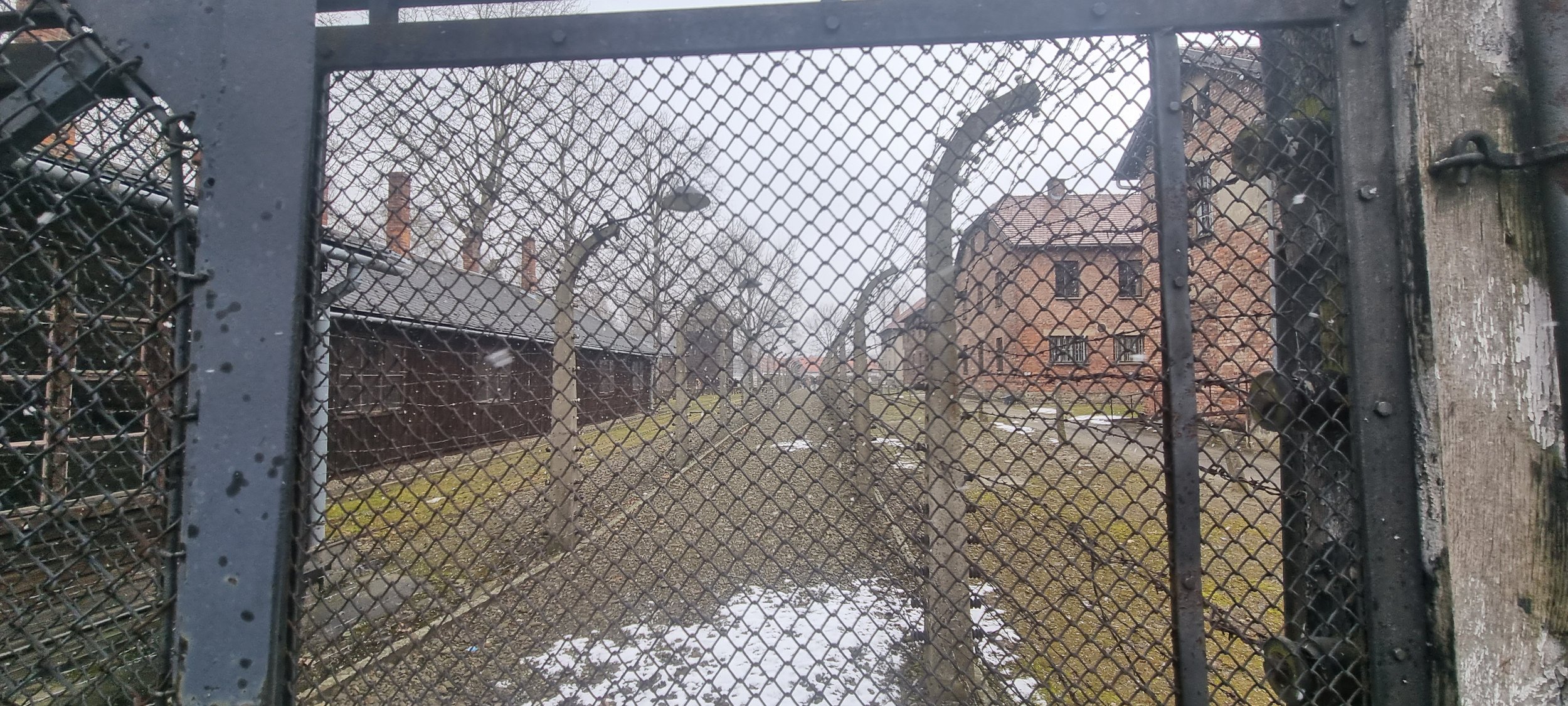
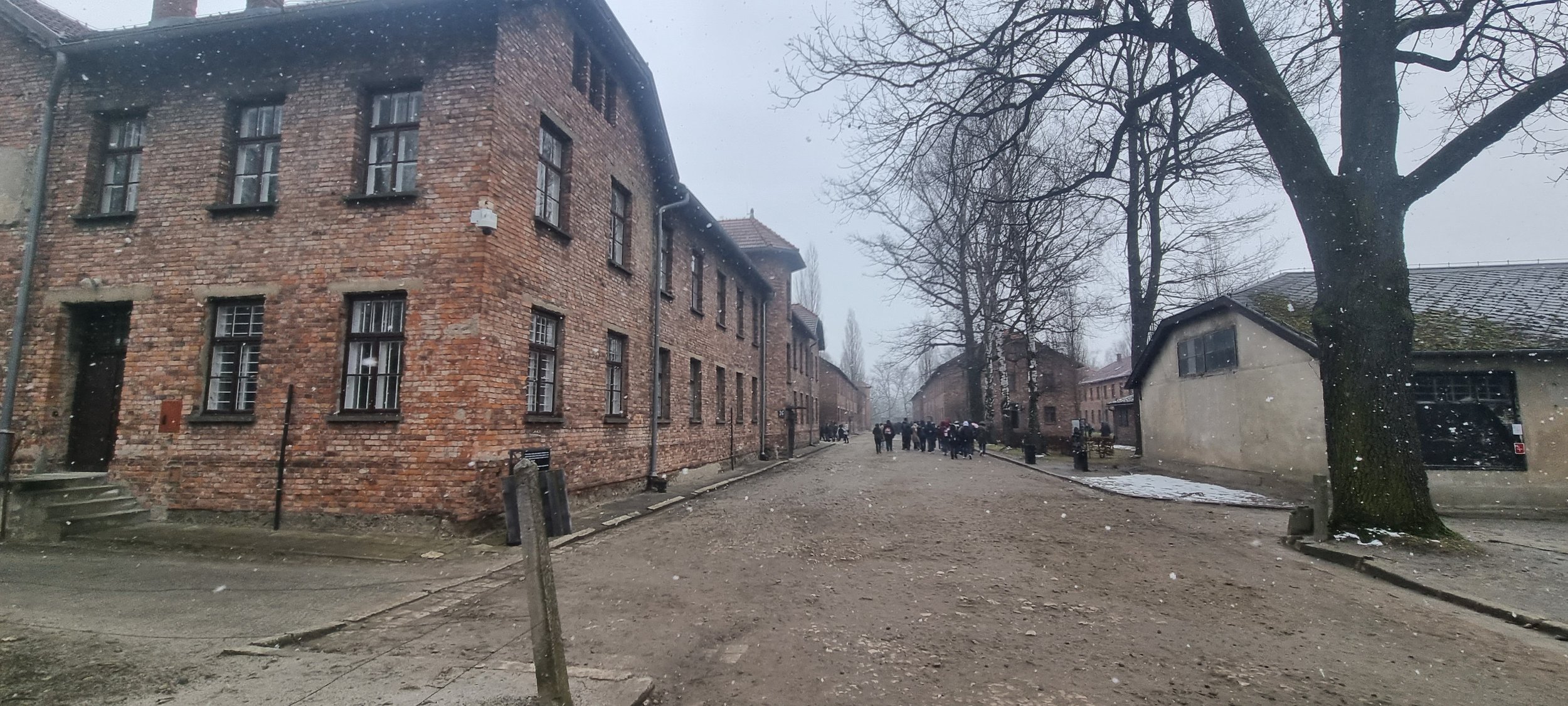



![Maria Mandl writes - "In my block [Block 15], 700 women were chosen out of 1,000; in the whole camp (that is, in lager A, where we stayed in the so-called quarantine), Mandl selected several thousand women, and all of them – naked – were crammed into](https://images.squarespace-cdn.com/content/v1/64a021b36f9f38433b9c30b6/266289b1-cee4-4e52-b87b-3ab588ba61d0/20230305_112944.jpg)




